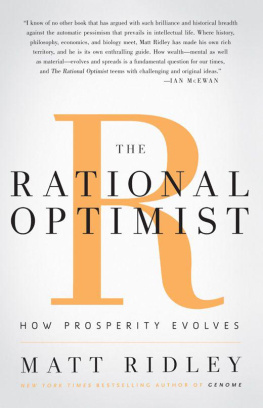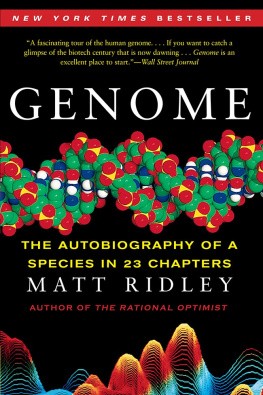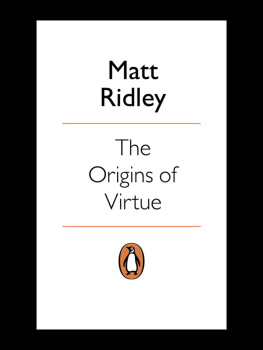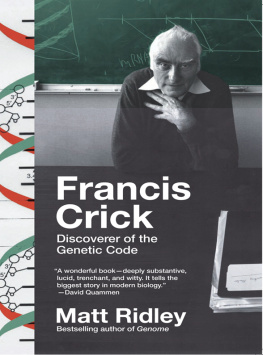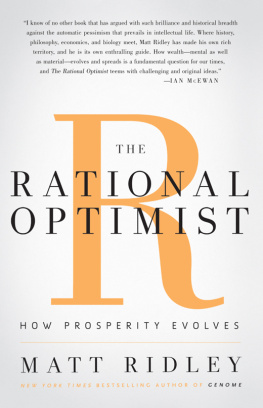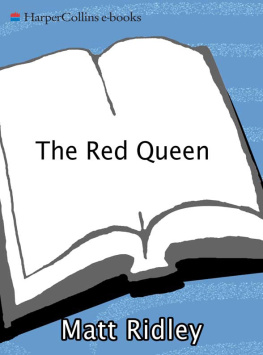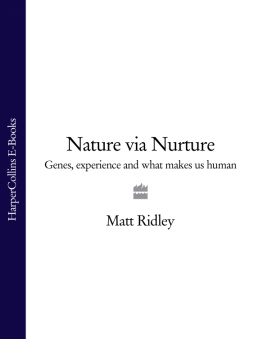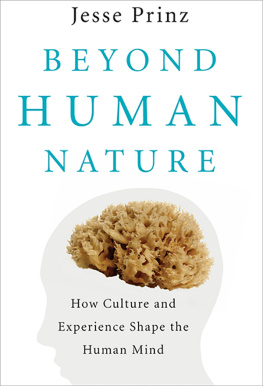THE AGILE
GENE
How Nature Turns on
Nurture

Matt Ridley

Perennial
An Imprint of HarperCollinsPublishers
For Jim
CONTENTS
Perverse Mankind! Whose wills, created free,
Charge all their woes on absolute Decree;
All to the dooming Gods their guilt translate,
And follies are miscalld the crimes of Fate.
Homers Odyssey, translated by
Alexander Pope
Revealed: the secret of human behaviour, read the banner headline in the British Sunday newspaper the Observer on 11 February 2001. Environment, not genes, key to our acts. The source of the story was Craig Venter, the self-made man of genes who had built a private company to read the full sequence of the human genome (his own) in competition with an international consortium funded by taxes and charities. That sequencea string of three billion letters composed in a four-letter alphabet containing the complete recipe for building and running a human bodywas to be published later in the week. The first analysis had revealed that there were just 30,000 genes in the human genome, not the 100,000 that many had been estimating up until a few months before.
Details had already been circulated to journalists, though under an embargo. But Venter spilled the story at an open meeting in Lyon on 9 February. Robin McKie of the Observer was in the audience and recognized at once that the figure 30,000 was now public. He went up to Venter and asked him if he realized that this broke the embargo; he did. Not for the first time in the increasingly bitter rivalry over the genome project, Venters version of the story would hit the headlines before that of his rivals. We simply do not have enough genes for this idea of biological determinism to be right, Venter said to McKie. The wonderful diversity of the human species is not hard-wired in our genetic code. Our environments are critical.
Seeing the Observers first edition, other newspapers followed suit. Genome discovery shocks scientists: genetic blueprint contains far fewer genes than thoughtDNAs importance downplayed, proclaimed the San Francisco Chronicle later that Sunday. Not only had McKie scooped the story; Venter had set the theme.
This was the making of a new myth. In truth, the number of human genes changed nothing. Venters remarks concealed two massive non sequiturs: first, that fewer genes implied more environmental influences; and second, that 30,000 genes were too few to explain human nature where 100,000 would have been enough. As Sir John Sulston, one of the leaders of the human genome project, put it to me a few weeks later, just 33 genes, each coming in just two varieties (such as on or off), would be enough to make every human being in the world unique. There are more than 10 billion ways of flipping a coin 33 times. So 30,000 is not such a small number after all. Two multiplied by itself 30,000 times produces a number larger than the total number of particles in the known universe. Besides, if fewer genes meant more free will, that would make fruit flies freer than people, bacteria freer still, and viruses the John Stuart Mills of biology.
Fortunately, there was no need for such sophisticated calculations to reassure the population. People were not seen weeping in the street at the humiliating news that our genome had fewer than twice as many genes as a worms. Nothing had been hung on the number 100,000, which was just a bad guess. But it was fitting after a century of increasingly repetitive argument over environment versus heredity that the publication of the human genome should be broken on the procrustean bed of nature versus nurture. It was, with the possible exception of the Irish question, the intellectual argument that had changed least in the century just ended. It had divided fascists from communists as neatly as their politics. It had continued unabated through the discovery of chromosomes, DNA, and Prozac. It was fated to be just as bitterly debated in 2003 as it was in 1953, the year of the discovery of the structure of the gene, or in 1900, the year modern genetics began. Even the human genome, at its birth, was being claimed for nurture versus nature.
For more than 50 years sane voices have called for an end to the debate. Nature versus nurture has been declared everything from dead and finished to futile and wronga false dichotomy. Everybody with an ounce of common sense knows that human beings are a product of a transaction between the two. Yet nobody could stop the argument. Immediately after calling the debate futile or dead, the typical protagonist would charge into the battle himself and start accusing others of overemphasizing one or the other extreme. The two sides of this argument are the nativists, whom I will sometimes call geneticists, hereditarians, or naturians; and the empiricists, whom I will sometimes call environmentalists or nurturists.
Let me at once put my cards faceup. I believe human behavior has to be explained by both nature and nurture. I am not backing one side or the other. But that does not mean I am taking a middle of the road compromise. As Jim Hightower, a Texas politician, once said: There aint nothing in the middle of the road but a yellow line and a dead armadillo. I intend to make the case that the genome has indeed changed everything, not by closing the argument or winning the battle for one side or the other, but by enriching the argument from both ends till they meet in the middle. The discovery of how genes actually influence human behavior, and how human behavior influences genes, is about to recast the debate entirely. No longer is it nature versus nurture but nature via nurture. Genes are designed to take their cues from nurture. To appreciate what has happened, you will have to abandon cherished notions and open your mind. You will have to enter a world where your genes are not puppet masters pulling the strings of your behavior but puppets at the mercy of your behavior; a world where instinct is not the opposite of learning, where environmental influences are sometimes less reversible than genetic ones, and where nature is designed for nurture. These cheap and seemingly empty phrases are coming to life for the first time in science. I intend to tell bizarre stories from the deepest recesses of the genome to show how the human brain is built for nurture. My argument in a nutshell is this: the more we lift the lid on the genome, the more vulnerable to experience genes appear to be.
I imagine a photograph taken in the year 1903. It is of a group of men gathered at some international meeting, in a fashionable spot like Baden-Baden or Biarritz, perhaps. Men is not quite the right word, for though there are no women, there is one little boy, along with one baby and one ghost; but the rest are middle-aged or elderly men, mostly rich and all white. There are 12 of them and, as befits the time, there is a great deal of facial hair. There are two Americans, two Austrians, two Britons, two Germans, one Dutchman, one Frenchman, one Russian, and one Swiss.
It is, alas, an imaginary photograph, for most of these people never met each other. But, like the famous group photograph of physicists at Solvay in 1927the one that includes Einstein and Bohr and Marie Curie and Planck and Schrdinger and Heisenberg and Diracmy picture would capture that moment of ferment when a scientific endeavor throws up a host of new ideas. My 12 men were the ones who put together the chief theories of human nature that came to dominate the twentieth century.



